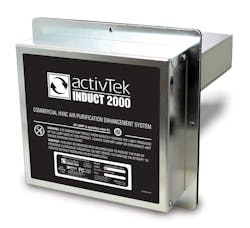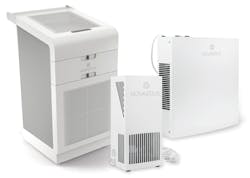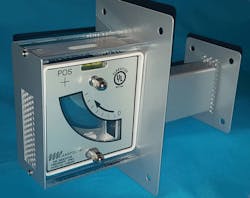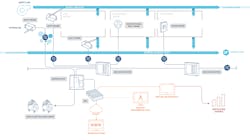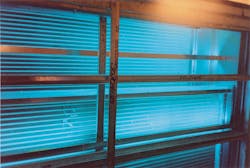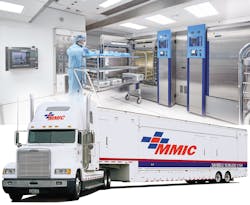Air and water. Necessities of life. We take them for granted, barely noticing either until something goes wrong.
Healthcare facilities possess potential for these life-giving properties to turn into life-taking properties. Waterborne pathogens such as Pseudomonas, non-tuberculous mycobacteria, and Legionella may lurk in water sources such as faucets, ice machines, showerheads, and plumbing, all of which send out aerosolized water droplets. The pathogen that perhaps gets the most attention is caused by Legionella. Legionnaires’ disease can cause deadly pneumonia from inhaling aerosolized droplets of contaminated water. It presents a danger to staff, visitors, and patients, particularly the immunocompromised.
Air is another source of epidemic respiratory infections in healthcare facilities. A report by Shrivastava et al noted, “This airborne transmission becomes even more prevalent in healthcare settings because of overburdened hospitals and the presence of immunosuppressed patients. Airborne infection control measures include a three-pronged approach, namely administrative control, environmental control, and personal respiratory protection measures.”1
Air- and waterborne diseases prompt healthcare systems to seek better, more effective ways of eliminating or containing problems and protecting patients from harm. Environmental controls are a large part of the solution.
A breath of fresh air
Florence Nightingale would be nearly 200 years old now. Not only is she recognized as the origin of modern nursing, she also contributed works on ventilation and hospital design. Beth Krah, Owner and CEO, activTek Health Solutions, cited a basic tenant touted by Florence Nightingale, who said, “The very first canon of nursing is to keep the air he breathes as pure as the external air, without chilling him.”
Krah’s position is that education is much needed on indoor air quality (IAQ) concerns, because airborne transmission of bacteria, viruses, and mold spores and off-gassing of volatile organic compounds (VOCs) affects patients’ ability to heal. She cited numerous areas of the hospital where airborne pathogens and VOCs lurk. “Exhaust vents harbor bacteria; remodeling loosens spores; mold spores cause infections in immunocompromised patients; and fungi is aerosolized from carpeting, which may cause respiratory distress for those with chronic obstructive pulmonary disease. For our efforts to be successful in providing healthy environments, these issues need to be addressed effectively.”
Krah added that their “reasonable price points afford smaller facilities the opportunity to provide healthy environments as well, compared to costly treatments few can afford.” Maintenance is minimal. Maintenance staff only need replace the radiant catalytic ionization cell annually.
Citing some of the advantages of reducing epidemiologically important pathogens, Krah said ActivePure can help to reduce the risk of infection, reduce re-admission rates, recoup Medicare funding, and elevate hospital ratings.
James Dacek, Senior Product Manager, STERIS, believes air quality is the next frontier in infection prevention in the operating room (OR). He said that whereas, “in recent years, the healthcare industry has addressed room surfaces, hand hygiene, gowning, etc., in the OR, there hasn’t been much emphasis placed on air as a primary source of contamination.” He also believes that education is in order, with hospital staff needing to be made aware of potential risks associated with out-of-spec air quality, i.e., temperature, humidity, particle counts, differential pressure, etc., per ASHRAE [American Society of Heating, Refrigerating and Air-Conditioning Engineers] 170.
Talking about why Dacek believes STERIS’s CLEANSUITE is the best for meeting healthcare facilities’ air-quality needs, he explained how the CLEANSUITE ceiling system helps mitigate the risk of airborne particles. He described it as, “A true gapless laminar-flow ceiling system, designed to minimize turbulence and gently guide particles away from the surgical site, bathing the patient and staff in ultra-clean air.” Dacek averred, “At 100 particles per cubic foot, it is the only solution to achieve the ISO Class 5 Cleanroom specification, surpassing the ASHRAE 170 standard for patient safety.”
CLEANSUITE ceiling system features a flexible, modular design and integrates structure, air delivery, and room lighting. “Internal and external truss systems allow for seamless mounting of surgical lights, booms, monitors and c-arms,” added Dacek. Further claims are that CLEANSUITE’s prefabricated structural steel frame installs six times faster than traditional site-built ceilings, which helps maximize OR uptime, and, a national design and construction firm’s recent data confirmed CLEANSUITE as being thirty percent less expensive than a traditional site-built ceiling.
“Air quality within healthcare settings is often overlooked but deserves attention, given one third of hospital-acquired infections (HAIs) are caused by airborne pathogens,” said Doug Jones, Vice President of US Channel Sales, Novaerus, part of WellAir. Jones believes that healthcare systems need to review their processes and protocol for air-quality management, establishing standards similar to those used for hand hygiene and sanitization of surfaces. “Infectious aerosols can be extremely small (<5 μm) and remain suspended in the air stream for long periods of time. In healthcare settings, a proactive method of continuous monitoring and cleaning of indoor air will assist in reducing HAIs and re-admissions.”
“WellAir has conducted independent efficacy testing that proves the Novaerus plasma technology reduces aerosolized biologicals, such as Staphylococcus epidermidis, MS2 bacteriophage, Aspergillus niger fungus, and Bacillus subtilis endospores,” continued Jones. “In addition, recent studies have proven that Novaerus technology reduces airborne Influenza A by up to 99.9%.”
A clinical trial performed by the National Health Service in the United Kingdom on the general medical/elderly care wards at the Royal Free Hospital, Hampstead, England, found, “You are 97% less likely to have MRSA [methicillin-resistant Staphylococcus aureus] outbreak if you use Novaerus.”2 The secondary finding concerns surface-count reduction: “Novaerus reduced total viable counts of surface bacteria by 23 percent on average for low heights (units on the floor) and 68 percent for high heights (units on table).”
Jones concluded, “If these units can prevent employee sicknesses and/or patient infections, the units will pay for themselves, compared to the costs associated with those issues. Also, with value-based reimbursement, facilities need to reduce re-admissions and HAIs to ensure they maximize their reimbursement.”
“The most difficult and costly device in any work environment is the one you must constantly replace or service,” averred Lybarger. “Lamiflow airflow indicators provide a lifetime of calibration-free service guarantee that avoids the stress and uncertainty. The most frustrating thing for service personnel is repeated service calls for the same issue.”
“Product attrition is a never-ending challenge in every hospital,” continued Lybarger. “Devices that you know will last, and products the staff can trust, are ultimately the most cost-effective.” He said Lamiflow indicators can stand the test of time with a near-zero percent failure rate. “Airflow has many important aspects, and pressure indication shouldn’t be a consuming focus for busy engineers. Avoid downtime and uncertainty with a device that won’t leave you guessing if it needs calibrating. In the world of airflow, that is a tremendous benefit for everyone involved,” said Lybarger.
Sarah Callahan, Marketing Manager, Aircuity, stated that Aircuity’s solution puts the patient first, taking into account the impact it has on infection control through better indoor environmental quality. “Designed for OR use, Clean Standby Mode is an application that continuously measures total VOCs, particles, and dew point. “During occupied times and operations, the OR runs at full occupied flows,” explained Callahan. “When unoccupied, if the air is clean, then the flow can be reduced and then increased again if containments are sensed.”
A bonus is that the smart data the platform provides also helps hospital officials with documentation such as for Joint Commission compliance. Callahan highlighted another benefit of their system: saving money and costs by providing a healthier space for patients and possibly reducing secondary inflection rates. “In addition, the opportunity for energy savings exists,” said Callahan. “Average energy savings with Aircuity’s platform can be as much as 75 percent in critical spaces and 10 to 30 percent in areas with variable population, such as waiting rooms or lobbies.”
Karl Oelker, Director Worldwide Sales, Steril-Aire, made a somewhat alarming statement. “The fact is that air-handling units (AHUs) are the largest reservoir and amplification device for microorganisms in a hospital.” Most of us never think about the potential for danger in the air when lying on a gurney or visiting someone who is.
Oelker went on to say, “We have taken more than 4,500 swab samples in 50 hospitals in 17 states over the past 10 years and found that not only are gram-negative bacteria found but gram-positive as well in AHUs, ductwork, and patient-room diffusors.”
Steril-Aire’s air-quality solution employs ultraviolet (UV) germicidal irradiation (GI; UVGI). “A specific wave length on the UV scale (257) can break down the DNA of organisms,” said Oelker. “The real question is how much UV energy is needed to inactivate microorganisms in a low-temperature environment. Steril-Aire has determined, through evidence-based design, that typical industry recommendations are not adequate for total coil cleaning.” Oelker said properly designed and installed UV does clean the coil, which is the heart of the problem. “This is important,” he said, “since bacteria will double itself in an AHU every 20 minutes and mold every two to four hours.” A further advantage of clean coils is that it saves energy, which translates into reduced costs for the facility.
As always, when researching a new product, published scientific studies are your friend. Oelker said, “Steril-Aire was involved in the only peer-reviewed, medically-published UV study on the reduction of HAIs in a neonatal intensive-care unit at Women’s and Children’s Hospital of Buffalo.2 The study was initiated to reduce the occurrence of ventilator-associated pneumonia (VAP), an HAI typically caused by the presence of Pseudomonas. These bacteria have been generally found in 50 percent of all AHUs sampled and in 30 percent of diffusors. In a 2 and a half-year period, Steril-Aire reduced VAP by 50 percent, resulting in saving more than $800,000 in hospital costs.”
Come on in, the water’s fine!
New construction or renovation at a hospital and local disasters of all kinds present an urgent need for clean air and water. Mobile Medical International Corporation (MMIC) makes it their business to ensure that medical facilities have options during such events.
CEO Jeffrey Paquet believes, “Mobile Medical International Corporation is the expert in providing temporary facilities to hospitals that are experiencing disruption or undergoing renovation in their surgical workflow areas. MMIC’s temporary surgery, endoscopy, and sterile-processing facilities, as well as water-treatment plants, are delivered to hospitals and commissioned to provide a code and guideline work environment for the hospital staff during these disruption periods.”
Paquet noted that their facilities meet FGI [Facility Guidelines Institute] guidelines for construction; follow ASHRAE 170 heating, ventilation, and air-conditioning design guidelines for air quality; comply with AAMI [Association for the Advancement of Medical Instrumentation] ST79 for sterile-processing guidelines, and AAMI TIR 34 water-quality guidelines for reprocessing of medical instruments.
Paquet, said, “With MMIC’s facilities in place, the hospital can continue work in a compliant environment while attending to the shortcoming of their own facility.” He outlined the real cost of non-compliance: shutdown of surgery operations, loss of associated revenue, and cost of outsourcing surgical-workflow activities to maintain operations. “In a very short period of time,” stated Paquet, “shutdowns can result in the permanent loss of surgeons to other hospitals, with lasting impacts on a hospital’s ability to recover from these events. Addressing the issues head-on, through investment, is the only cost-effective way to deal with the problem; the alternative is as costly, with no value added.”
In conclusion, Paquet expressed another concern. “There is a growing realization within the industry that secondary patient infections contracted in the hospital are a significant driver of healthcare costs. Healthcare accreditation organizations are taking an increased interest in air and water quality as a primary source of these infections. A significant percentage of healthcare facilities in the U.S. are not designed to meet today’s requirements or may have outdated equipment that is not capable of meeting the requirements. To address this problem, hospitals must put the appropriate focus on capital re-investment and expert management of their facilities.”
References
1. Shrivastava SR, Shrivastava PS, Ramasamy J. Airborne infection control in healthcare settings. Infect Ecol Epidemiol. 2013;3:10.3402/iee.v3i0.21411. Published online 2013 Jun 14. https://www.ncbi.nlm.nih.gov/pmc/articles/PMC3683632/
2. Ryan RM, Wilding GE, Wynn RJ, et al. Effect of enhanced ultraviolet germicidal irradiation in the heating ventilation and air conditioning system on ventilator associated pneumonia in a neonatal intensive care unit. J Perinatol. 2011 Sep;31(9):607-614. Epub 2011 Mar 24.
About the Author

Susan Cantrell
Susan Cantrell is Infection Prevention Editor for Healthcare Purchasing News.

